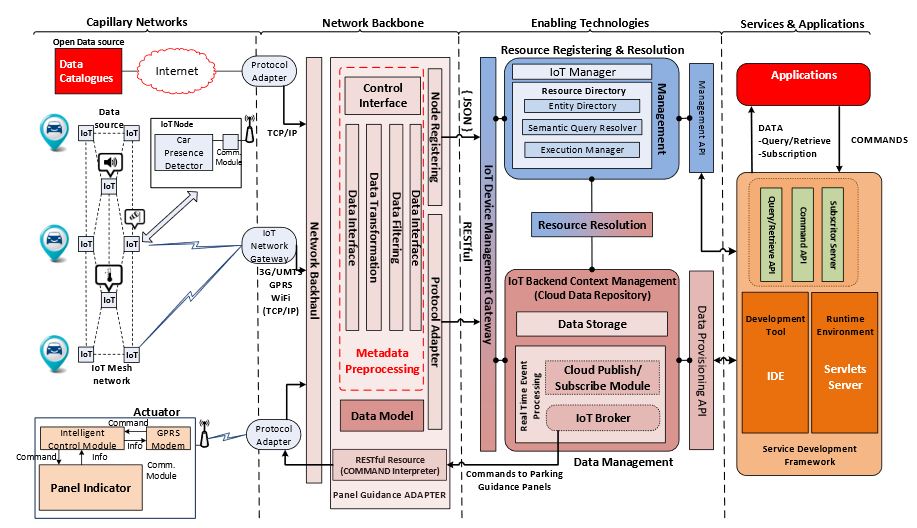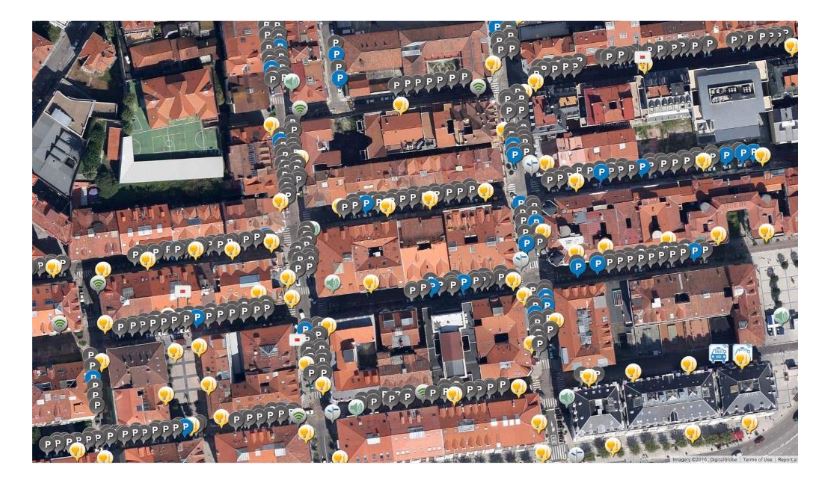ABSTRACT
Enhancing the effectiveness of city services and assisting on a more sustainable development of cities are two of the crucial drivers of the smart city concept. This paper portrays a field trial that leverages an internet of things (IoT) platform intended for bringing value to existing and future smart city infrastructures. The paper highlights how IoT creates the basis permitting integration of current vertical city services into an all-encompassing system, which opens new horizons for the progress of the effectiveness and sustainability of our cities.
Additionally, the paper describes a field trial on provisioning of real time data about available parking places both indoor and outdoor. The trial has been carried out at Santander’s (Spain) downtown area. The trial takes advantage of both available open data sets as well as of a large-scale IoT infrastructure. The trial is a showcase on how added-value services can be created on top of the proposed architecture.
RELATED WORK
There are two main ways of understanding the smart city term. On the one hand, a technology-oriented one that considers a ubiquitous computing scenario where a plethora of devices are embedded into the very fabric of urban environments. On the other hand, a more economic-oriented vision that focuses on the opportunities that are created for the development of a new knowledge-based economy. However, there is an aspect that appears in both of them. They both put in a central role the ability to capture data related to the city operations and analyze it to generate added-value information that will optimize these operations. IoT is seen as a key enabling technology in satisfying these functionalities.
CLOUD AND INTERNET OF THINGS (IOT)-ENABLED SMART CITY PLATFORM

Figure 2. Cloud and internet of things (IoT)-enabled smart city platform high-level architecture
Once the sensing and actuating substrate has been presented, this section summarizes the software platform that enables the development of applications and services exploiting the information gathered and the actions supported. Figure 2 shows the high-level architecture of the cloud and IoT-enabled smart city platform supporting the smart parking service. The platform has a four-tiered architecture where the capillary networks tier comprises the underlaying infrastructure formed by all the sensors, actuators and IoT devices in general. The diversity of devices and technologies is addressed in this tier. In the specific case of the Santander deployment for the smart parking service, the sensors used were all based on the same technology featuring magnetometers that detected when a car enters or leaves the monitored parking place.
CASE STUDY: SMART PARKING TRIAL

Figure 3. Detailed view of outdoor parking sensors deployment
ICT technologies in general and IoT in particular, characterized by its pervasiveness, are becoming a very attractive transversal enabler in reducing carbon monoxide (CO) emissions and other pollutants, as well as petrol consumption. Ferromagnetic wireless sensors buried under the asphalt (or any other parking spaces monitoring technology) can be used to continuously monitor parking spaces status and detect when cars arrives and leaves such lots. Subsequently, this information can be gathered and made available in real-time to drivers, traffic control responsible staff and local authorities so that appropriate actions can be taken (i.e., plan the route to the nearest place, control the usage and establish policies respectively). Figure 3 shows the satellite view of parking detection sensors deployed at some streets in Santander downtown area.
CONCLUSIONS
This paper presents a field-trial case based on the smart parking application and service which were developed and run on top of a cloud and IoT-based smart city platform. Moreover, the paper introduces the high-level architecture for this platform. It addresses key smart city paradigm requirements and enables the development of added-value services, like the one introduced in the article, by integrating in its design, concepts of IoT, and cloud technologies. This work shows that the value of IoT infrastructures is only leveraged by the ability to virtualize the underlying complexity through well-defined interfaces and enablers that enable easy development and instantiation of services and applications that makes use of the data generated and accesses the actuation capabilities of the myriad of devices that coexist in the smart city ecosystem.
Additionally, by implementing a smart solution for one of the most demanded smart city service, namely parking, in this work it has been possible to carry out an assessment of the benefits that the wide-scale introduction of this kind of solutions can bring to the cities of the future. In conclusion, this paper provides a review of the implementation and assessment of a prototype smart parking service supported by real-world large-scale IoT infrastructure and the results showed that this kind of service can bring important benefits in the efficiency of currently run services.
No detailed analysis of the impact of the solution is provided since the contribution of the paper is to present how a holistic ICT-based platform is able to support the development and deployment of smart services in a real city environment. Particularly, through the actual implementation and deployment of a smart parking use case in a real-world scenario. The integrated approach introduced in this work would serve as a proof-of-concept for development of novel smart city services in the near future tacking additional services linked to efficient use of renewable energies, electrical mobility, and gamification and rewarding mechanisms.
Source: University of Cantabria
Authors: Jorge Lanza | Luis Sanchez | Veronica Gutierrez | Jose Antonio Galache | Juan Ramon Santana | Pablo Sotres | Luis Munoz
>> 200+ IoT Led Projects for Final Year Students
>> IoT Environmental Monitoring System for Smart Cities Projects for Students
>> IoT Software Projects for Final Year Students
>> More Wireless Sensor Networks Projects Abstract for Final Year Students